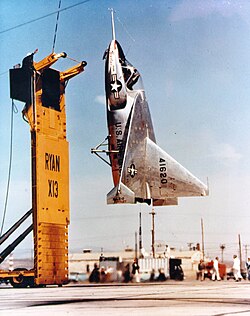Ryan X-13
| Ryan X-13 | |
|---|---|

|
|
| Type: | Experimental airplane |
| Design country: | |
| Manufacturer: | |
| First flight: |
December 10, 1955 |
| Commissioning: |
Flight tests ended in 1957 |
| Production time: |
Was never mass-produced |
| Number of pieces: |
2 |
The Ryan X-13 Vertijet was an experimental aircraft with a jet engine , which could take off and land from a vertical position and thus belongs to the genus of the tail starter . In contrast to other aircraft of this type, however, the X-13 had no rollers at the rear on which to stand, but required a ramp. A safety rope was attached to the upper end of this ramp, to which the X-13 was hooked by means of a hook on the bow of the fuselage under the cockpit .
history
At the start of the X-13 program, some engineers from the Ryan Aeronautical Company considered whether the FR-1 Fireball would be suitable for vertical takeoffs and landings. Some drafts for future VTOL aircraft were published, and in 1947 the United States Navy signed a contract with Ryan to develop a submarine- assisted and jet-powered VTOL aircraft.
Ryan decided that a variable thrust jet engine would be the best solution and signed a follow-up contract to build an unmanned prototype . This prototype first flew on October 20, 1950, powered by an Allison J33 jet engine. After further test flights, a cockpit was installed (which consisted of the fuel tank of a Boeing B-47 ) and so on November 24, 1953 the first manned flight with test pilot Peter Girard took place. So Ryan was able to gain important experience for the construction of the X-13 .
However, the Navy stopped supporting the program in order to tender a new development for propeller-driven stern starters, in which Ryan did not participate. However, the Air Force had observed the program and commissioned Ryan to redesign a vertical take-off aircraft, now officially designated the X-13 . It should have the properties of a stern starter required by the Navy and, like Ryan's earlier test aircraft, be equipped with a jet engine.
Ryan then built an aircraft with a short fuselage, delta wings and a conventional, rigid landing gear , which was an unusual structural design for a rear starter. The first Vertijet (serial number 54-1619) took off on December 10, 1955. The X-13 completed the first tests in normal level flight to check its airworthiness, for which the landing gear was also installed.
The first vertical hover flight took place on May 28, 1956. The technicians had omitted the landing gear on the second prototype, instead of the nose wheel, a catch hook was attached, and the main wheels had been reduced to small supports. The X-13 was supposed to hook onto a rope that was attached to a launch pad. Since the pilot had poor visibility downwards (which was a major obstacle for the other tail starter developments), simple height markings were made on the ramp, which made it easier for the pilot to latch in and out. The transition from hovering to level flight took place for the first time on November 28, 1956, and on April 11, 1957 the first "complete" flight took place with notching from the ramp, transition to level flight and back to hovering flight and finally re-latching into the ramp instead of. During a demonstration in front of over 3,000 spectators, this process was repeated on July 30 of the same year.
The last time the X-13 flew on September 30, 1957, the program was suspended. The X-13 had met the expectations of this test model; however, the development of further rear starters was already seen as a dead end, which prevented a successor model. The first X-13 is now owned by the National Air and Space Museum and is on loan from the San Diego Aerospace Museum , California . The second specimen is on display at the National Museum of the United States Air Force in Dayton , Ohio .
Technical specifications
| Parameter | Data |
|---|---|
| length | 7.14 m |
| span | 6.40 m |
| Takeoff mass | 3317 kg |
| Top speed | 777 km / h |
| Service ceiling | nb, the maximum altitude attained was about 10,000 feet |
| Range | 310 km |
| Engines | 1 Rolls-Royce - Avon RA.28 Mk 49 with 44.5 kN (4534 kp) static thrust |
See also
Web links
Individual evidence
- ↑ Description on history.nasa.gov p. 19. (PDF; 1.2 MB) Accessed January 12, 2013 .